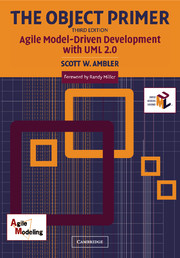Book contents
- Frontmatter
- Contents
- Acknowledgments
- Foreword
- Preface
- About the Author
- Chapter 1 Leading-Edge Software Development
- Chapter 2 Understanding the Basics–Object-Oriented Concepts
- Chapter 3 Full Lifecycle Object-Oriented Testing (FLOOT)
- Chapter 4 Agile Model–Driven Development (AMDD)
- Chapter 5 Usage Modeling
- Chapter 6 User-Interface Development
- Chapter 7 Supplementary Requirements
- Chapter 8 Conceptual Domain Modeling
- Chapter 9 Business Process Modeling
- Chapter 10 Agile Architecture
- Chapter 11 Dynamic Object Modeling
- Chapter 12 Structural Design Modeling
- Chapter 13 Object-Oriented Programming
- Chapter 14 Agile Database Development
- Chapter 15 Where to Go from Here
- Glossary
- References and Recommended Reading
- Index
Foreword
Published online by Cambridge University Press: 03 March 2010
- Frontmatter
- Contents
- Acknowledgments
- Foreword
- Preface
- About the Author
- Chapter 1 Leading-Edge Software Development
- Chapter 2 Understanding the Basics–Object-Oriented Concepts
- Chapter 3 Full Lifecycle Object-Oriented Testing (FLOOT)
- Chapter 4 Agile Model–Driven Development (AMDD)
- Chapter 5 Usage Modeling
- Chapter 6 User-Interface Development
- Chapter 7 Supplementary Requirements
- Chapter 8 Conceptual Domain Modeling
- Chapter 9 Business Process Modeling
- Chapter 10 Agile Architecture
- Chapter 11 Dynamic Object Modeling
- Chapter 12 Structural Design Modeling
- Chapter 13 Object-Oriented Programming
- Chapter 14 Agile Database Development
- Chapter 15 Where to Go from Here
- Glossary
- References and Recommended Reading
- Index
Summary
Agile software development has moved from the fringes of the software development community to the mainstream. This movement is driven by the need to produce better software faster, which is integral to developing competitive advantage in the global software community. From North America to Asia and everywhere in between, the ability to deliver software that delights the customer has become a critical success factor. The agile community particularly focuses on that customer and ensures that he or she receives maximum value.
Much of the way that we traditionally built software was based on the constraints posed by the systems of old. The amount of time needed to compile these systems was large and software development processes were built around this activity. Getting the code right the first time was important to maximize productivity in this environment. However, many of today's integrated development environments (IDEs) no longer require us to compile the whole system to add some new functionality. In fact, newer compilers often help us get the syntax of our programs correct as we are writing it.
The agile software development movement is taking advantage of the lifting of these constraints. All agile software development processes focus on creating small increments of functionality using an iterative approach. This new approach is in contrast to the “big bang” or waterfall approach where the software is delivered all at one time. Again, today's technology and software development processes allow us to lift another constraint.
- Type
- Chapter
- Information
- The Object PrimerAgile Model-Driven Development with UML 2.0, pp. xix - xxPublisher: Cambridge University PressPrint publication year: 2004
- 1
- Cited by

